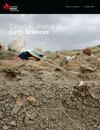加拿大北极地区的残岩和熟料:可追溯到中新世晚期的燃烧变质作用记录
IF 1.6
4区 地球科学
Q3 GEOSCIENCES, MULTIDISCIPLINARY
引用次数: 0
摘要
露头带有明显的红色到黄色的熟料,带黑色的斜岩,以及两者的混合,具有角砾岩样的外观,出现在加拿大的北极地区。我们在埃尔斯米尔岛、班克斯岛和麦肯齐三角洲地区检查了这种岩石。这些岩石分别是白垩系和古近系寄主沉积岩中烟煤页岩和低煤阶煤层自然燃烧的产物。熟料和硅酸盐副矿渣样品的主要矿物相为石英+赤铁矿±长石±方英石(或黄璧石)±堇青石-绢云石±斜辉石±硅线石±玻璃。由赤铁矿±磁铁矿±斜辉石组成的渣状氧化铁副岩(74 ~ 95 wt.%总Fe2O3)产于富含菱铁矿结核的古近系寄主沉积岩中。同一露头样品的熟料和硅酸盐副滑石的全岩地球化学组成具有相似性。区域和局部特定元素富集主要继承自沉积原岩,其特征为火山源输入(古新世沉积岩)或缺氧沉积条件(上白垩统沥青沉积岩)。当富含有机物的沉积岩暴露在大气中的氧气中时,就会发生自燃。这一过程至少在埃尔斯米尔岛(6.1±0.2 Ma)的迈西尼亚阶段(中新世)开始发生;40Ar39Ar增量加热定年(全岩准斜岩),并持续至今。在埃尔斯米尔岛(Ellesmere Island)观察到煤层和碎屑尤里卡海峡群沉积岩在岩石上的活跃燃烧过程。本文章由计算机程序翻译,如有差异,请以英文原文为准。
Paralava and clinker from the Canadian Arctic: A record of combustion metamorphism dating back to the late Miocene
Outcrops with conspicuous reddish to yellow-colored clinker, blackish paralava, and blends of both with a breccia-like appearance occur across the Canadian Arctic. We examined such rocks on Ellesmere Island, Banks Island, and the Mackenzie Delta area. These rocks are a product from natural combustion of bituminous shale and low-rank coal seams in Cretaceous and Paleogene host sedimentary rocks, respectively. The main mineral phases of clinker and silicate paralava samples are comprised of quartz + hematite ± feldspars ± cristobalite (or tridymite) ± cordierite–sekaninaite ± clinopyroxene ± sillimanite ± glass. Slag-like iron-oxide paralava (74–95 wt.% total Fe2O3) consisting of hematite ± magnetite ± clinopyroxene occur in Paleogene host sedimentary rocks rich in siderite concretions. The whole-rock geochemical composition of clinker and silicate paralava shows similarities for samples from the same outcrop. Regional and local specific elemental enrichments are mainly inherited from the sedimentary protoliths, which are characterized by volcanogenic input (Paleocene sedimentary rocks) or oxygen depleted depositional conditions (Upper Cretaceous bituminous sedimentary rocks). Spontaneous combustion could take place when the organic-rich sedimentary rocks become exposed to atmospheric oxygen. This process has occurred at least since the Messinian stage (Miocene) on Ellesmere Island (6.1 ± 0.2 Ma; 40Ar39Ar incremental heating dating on whole-rock paralava) and continues until now. An active combustion process on scree from a coal seam and clastic Eureka Sound Group sedimentary rocks was observed on Ellesmere Island.
求助全文
通过发布文献求助,成功后即可免费获取论文全文。
去求助
来源期刊

Canadian Journal of Earth Sciences
地学-地球科学综合
CiteScore
2.80
自引率
7.10%
发文量
66
审稿时长
6-12 weeks
期刊介绍:
The Canadian Journal of Earth Sciences reports current research in climate and environmental geoscience; geoarchaeology and forensic geoscience; geochronology and geochemistry; geophysics; GIS and geomatics; hydrology; mineralogy and petrology; mining and engineering geology; ore deposits and economic geology; paleontology, petroleum geology and basin analysis; physical geography and Quaternary geoscience; planetary geoscience; sedimentology and stratigraphy; soil sciences; and structural geology and tectonics. It also publishes special issues that focus on information and studies about a particular segment of earth sciences.
 求助内容:
求助内容: 应助结果提醒方式:
应助结果提醒方式:


